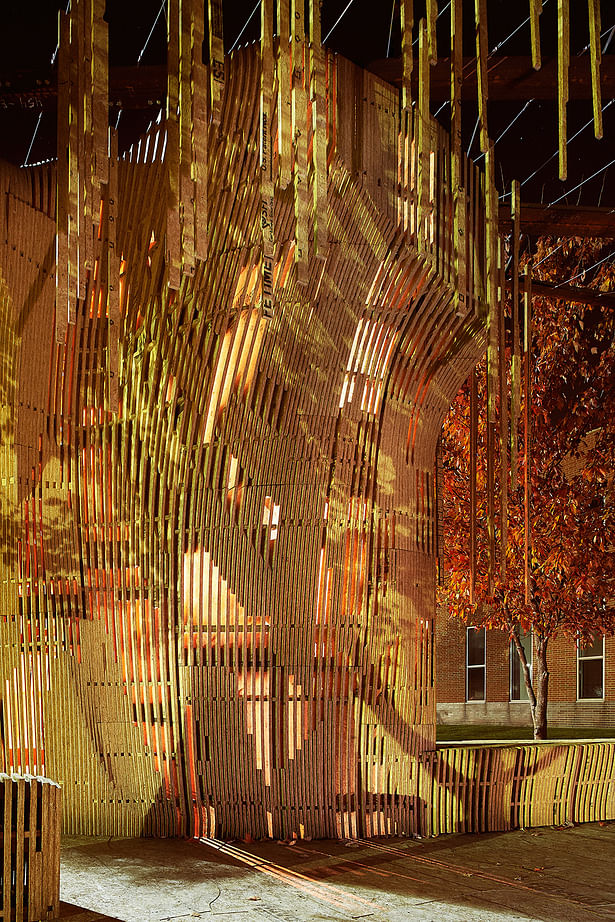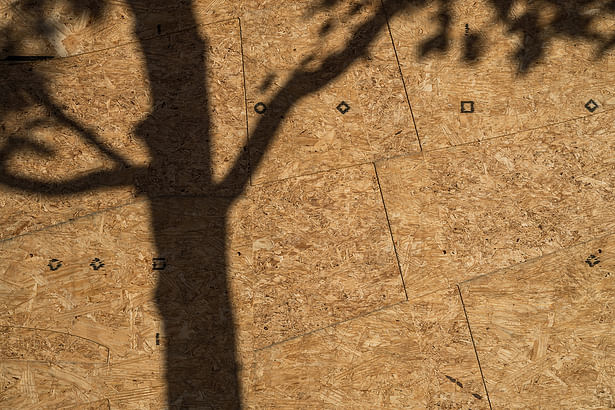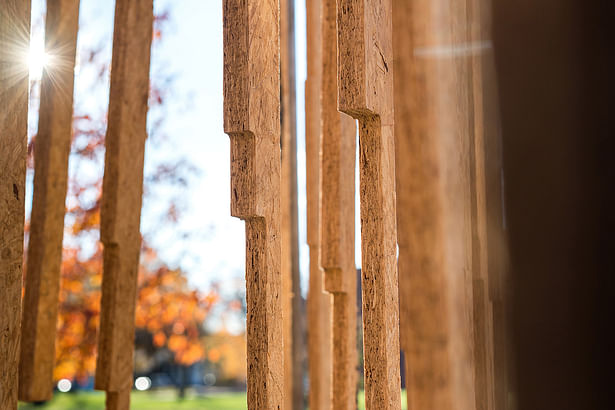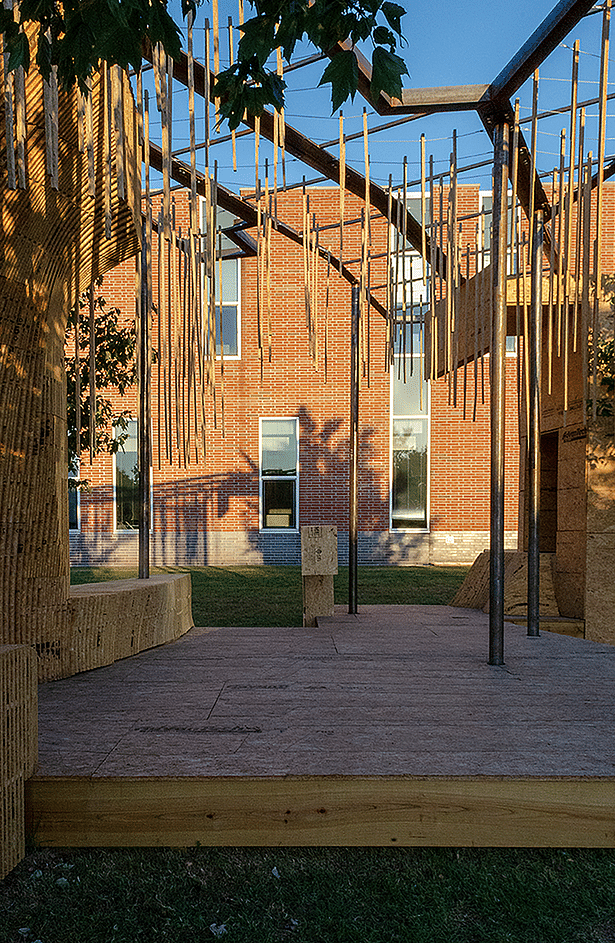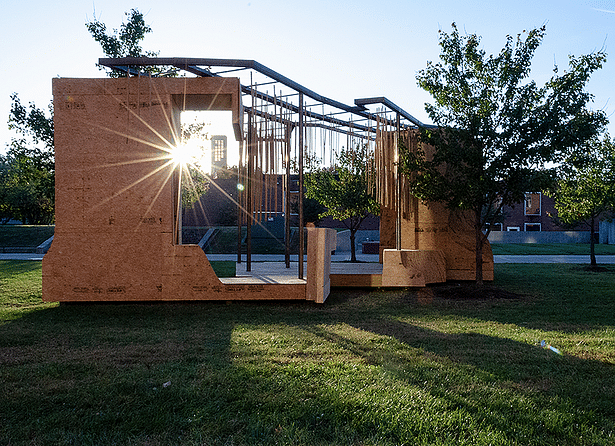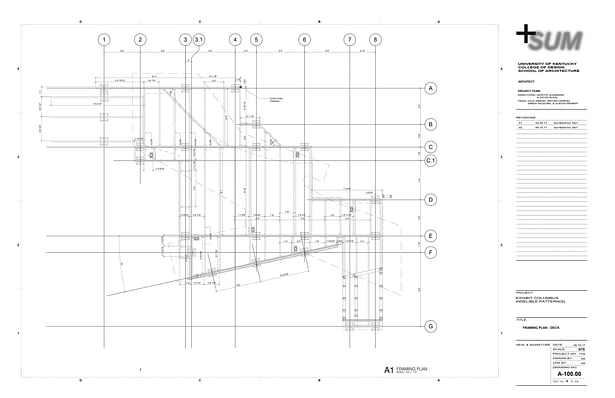
“Indelible Pattern(s)” is a living laboratory of architectural education within the rich and layered history of architecture in Columbus, Indiana. In this context, the project sought to inscribe itself within its layered context through site-specific relationships across multiple scales that are clear if one is observant. Other relationships are less clear, allowing the project to be an extension of its site and simultaneously and object of wonder and speculation. It is an open-ended provocation to encourage interaction, speculation, and discovery over time.
The installation was part of the University Installations of the inaugural Exhibit Columbus Design Biennial in 2017. The project was initiated as a design build studio at the University of Kentucky College of Design, School of Architecture and led by Martin Summers and David Biagi, later finalized and completed by PLUS-SUM Studio. The project was made possible in part by the generous support of Exhibit Columbus, the University of Kentucky College of Design, Nomi Architecture, Design, Fabrication, Butch Branson and Tim Skinner. Partial material support by Huber Engineered Woods.
The design brief for Exhibit Columbus Biennial stated that the University Installations “represent the state of architectural education as well as speculate on the potential to be a catalyst for changing the way we design and build in the Midwest ... expanding design literacy through education.” This statement and the broader brief aligned with a prior research agendas to strategically blur the lines between the academy and professional practice and with adaptable design strategies operating at multiple scales. The project site is also multi-scalar in nature, situated within the rich cultural context of Columbus, Indiana and located in the landscape between two schools. This specific context turned the city and site into a classroom for architecture and design. Indelible Pattern(s) was designed to be challenging and didactic to visitors, telling multiple, simultaneous stories - if one takes time to explore and observe.
The project initially presents itself as a single habitable space, organized by a hanging swarm canopy above and an inscribed deck below. It requires visitors to move around and through to see these direct alignments and discover multiple indirect allusions. Visitors who slow-down, contemplate and observe, find the initial spatial simplicity as a subterfuge concealing a complex set of overlapping spaces and patterns. As one looks closer at these micro-spaces, the site and city are recontextualized as active participants forming and informing this new, temporary place. Columbus’s Modernist History is formally absorbed via regulating lines within the context while large, clearly defined voids pierce the installation framing iconic vertical moments contrasting the horizontality of the region. Patterns that are more graphic in nature are less identifiable and subtler in their operations. Two examples are the hanging swarm and the razzle-dazzle pattern in the laminated structures. The swarm reveals pixelated volumes that appear and recede as one moves and the razzle-dazzle transforms from a solid mass to thin apertures depending on the angle of view. Other tectonic assembly patterns and designed geometries allude to indelible cultural landmarks.
These contradictory smooth and discrete typologies, designed around and with the landscaping, define micro-spaces that inscribe the structure with site specificity while other organizational rules evade, obfuscate, or delay comprehension. By juxtaposing these clear organizational alignments with less physically identifiable computational rules, visitors are left with moments of clear identification and a gap in their complete understanding. Without a single story or simple answers, visitors are left with lingering questions and personal discoveries that are felt beyond the temporary exhibit, the foundation of an individual’s education.
Pedagogical Agenda:
The design process begins with an abstract, formal, multi-scalar research agenda that gets fine-tuned through hundreds of iterations as the project's constraints are understood, absorbing information and increasing precision as the design evolves. Layered into this formal agenda were contradictory interests where patterns (camouflage and glitch) obfuscate and confuse the formal precision with a secondary digital precision that is difficult for a visitor to reconcile.
The projects language operates through abstract formal systems combined with Grasshopper scripts, producing a hybrid workflow from initial concept to construction. Grasshopper scripts became critical to the fabrication and construction workflows, allowing a method to subdivide the structure into puzzle parts then subdivide the puzzle parts into individual components, where pattern and structure merge. Once the individual components were produced, a designer would then locate the structural connection points between adjacent puzzle pieces and detail these individually. After this, another Grasshopper script translated the individual components from 3d to 2d with associated identification tags for fabrication. While initially, the goal was to pack the CNC sheets with a script, it was faster and more materially efficient to do this manually, allowing odd parts to move between sheets, therefore, minimizing overall waste and cost. The final assembly on site referenced the digital model as a template for the construction, minimizing construction documents (wasted resources) to the base framing of the deck and the steel fabrication drawings, completed by professionals outside the design team.
Additional research agendas regarding direct-to-fabrication processes, advanced digital workflows, minimum waste, and integrated modeling were critically deployed. Parametric tools evolved with the design and parametric workflows tested the limits of an integrated model as construction document, minimizing construction drawings. The project used the design model to model a pedagogy that blurs academia and practice - producing a living laboratory of current and future practice that prepares student participants for their immediate future in beyond the walls of academia.
Status: Built
Location: Columbus, IN, US
Firm Role: Martin Summers led the student team through concept, design, fabrication and installation.
Additional Credits: Design Team:
Assistant Professor Martin Summers
Associate Professor David Biagi
Students:
Nick Abend (4UG)
Bryan Hardin (1G)
Drew McGurk (1G)
Alexis Peneff (2G)
Construction/Fabrication:
Students:
Nick Abend
Eric Lowe
Freddy Maggioarani
Drew McGurk
Alexis Peneff
Ari Sogin
Faculty:
Jordan Hines
Brian Richter
Martin Summers
Bruce Swetnam
Others:
Armondo Noriega
Jonathan Rencon
Erin Ruhl
On-Site Assistance:
Josh Coggeshall
Richard McCoy
Jonathan Nesci
Janice Shimizu
Anne Surak
Kelly Wilson
Lance Schneider
Steel Fabrication (Water Jet Cuts)
Rob Moses at 502 Fabrication and Manufacturing
Steel Fabrication
Intertech Mechanical Services
CNC and Workspace:
Nomi Architecture, Design, Fabrication
Matthew Brooks
Jeremy Clements
Temporary Storage:
Kelly Wilson and IUCAD
Lodging:
Lance and Bianca Schneider
Financial Sponsors:
Exhibit Columbus
Butch Branson
Tim Skinner
Martin Summers
The University of Kentucky College of Design
Partial Material Financial Support:
Jason Ralston at Huber Engineered Woods
Lexington Building Supply
